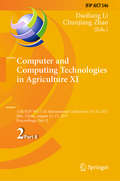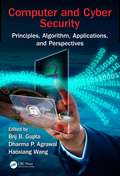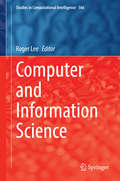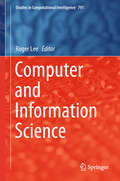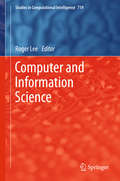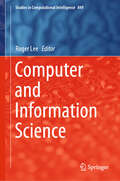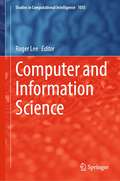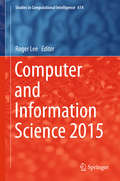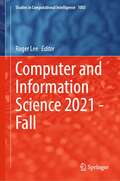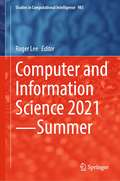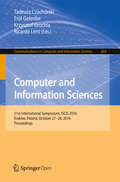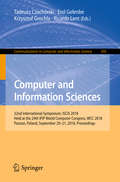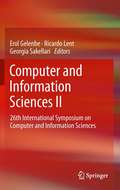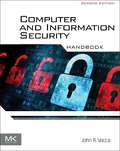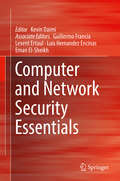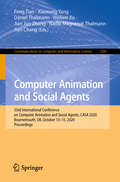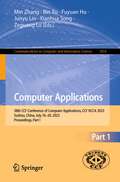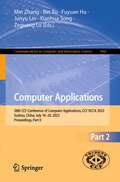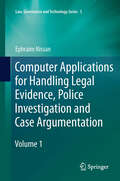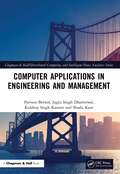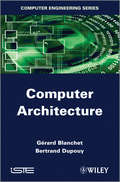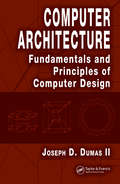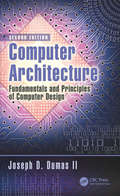- Table View
- List View
Computer and Computing Technologies in Agriculture XI: 11th IFIP WG 5.14 International Conference, CCTA 2017, Jilin, China, August 12-15, 2017, Proceedings, Part II (IFIP Advances in Information and Communication Technology #546)
by Daoliang Li Chunjiang ZhaoThe two volumes IFIP AICT 545 and 546 constitute the refereed post-conference proceedings of the 11th IFIP WG 5.14 International Conference on Computer and Computing Technologies in Agriculture, CCTA 2017, held in Jilin, China, in August 2017.The 100 revised papers included in the two volumes were carefully reviewed and selected from 282 submissions. They cover a wide range of interesting theories and applications of information technology in agriculture. The papers focus on four topics: Internet of Things and big data in agriculture, precision agriculture and agricultural robots, agricultural information services, and animal and plant phenotyping for agriculture.
Computer and Cyber Security: Principles, Algorithm, Applications, and Perspectives
by Brij B. GuptaThis is a monumental reference for the theory and practice of computer security. Comprehensive in scope, this text covers applied and practical elements, theory, and the reasons for the design of applications and security techniques. It covers both the management and the engineering issues of computer security. It provides excellent examples of ideas and mechanisms that demonstrate how disparate techniques and principles are combined in widely-used systems. This book is acclaimed for its scope, clear and lucid writing, and its combination of formal and theoretical aspects with real systems, technologies, techniques, and policies.
Computer and Information Science (Studies in Computational Intelligence #566)
by Roger LeeThepurposeofthe 7thIEEE/ACISInternationalConferenceonComputerandInfor- tion Science (ICIS2008)and the 2nd IEEE/ACISInternationalWorkshop on e-Activity (IWEA 2008) to be held on May 14-16, 2008 in Portland, Oregon, U. S. A. is to bring together scientists, engineers, computer users, and students to share their experiences and exchange new ideas and research results about all aspects (theory, applications and tools) of computer and information science; and to discuss the practical challenges - countered along the way and the solutions adopted to solve them. In January, 2008 one of editors of this book approached in house editor Dr. Thomas Ditzingeraboutpreparingavolumecontainingextendedandimprovedversionsofsome of the papers selected for presentation at the conference and workshop. Upon receiving Dr. Ditzinger's approval, conference organizers selected 23 outstanding papers from ICIS/IWEA 2008, all of which you will nd in this volume of Springer's Studies in Computational Intelligence. In chapter 1, Fabio Perez Marzullo et al. describe a model driven architecture (MDA) approachfor assessing database performance. The authorspresent a pro ling technique that offers a way to assess performance and identify aws, while performing software construction activities. In chapter 2, authorsHuy Nguyen Anh Pham and EvangelosTriantaphyllouoffera new approachfortesting classi cation algorithms, and present thisapproachthroughrean- ysis of the Pima Indian diabetes dataset, one of the most well-known datasets used for this purpose. The new method put forth by the authors is dubbed the Homogeneity- Based Algorithm(HBA), and it aims to optimally control the over ttingand overgen- alization behaviors that have proved problematic for previous classi cation algorithms on this dataset.
Computer and Information Science (Studies in Computational Intelligence #791)
by Roger LeeThis book presents the outcomes of the 17th IEEE/ACIS International Conference on Computer and Information Science (ICIS 2018), which was held in Singapore on June 6–8, 2018. The aim of the conference was to bring together researchers and scientists, businessmen and entrepreneurs, teachers, engineers, computer users, and students to discuss the various fields of computer science and to share their experiences, and to exchange new ideas and information in a meaningful way. The book includes findings on all aspects (theory, applications and tools) of computer and information science and discusses related practical challenges and the solutions adopted to solve them. The conference organizers selected the best papers from those accepted for presentation. The papers were chosen based on review scores submitted by members of the program committee and underwent a further rigorous round of review. From this second round, 13 of the conference’s most promising papers were then published in this Springer (SCI) book and not the conference proceedings. We impatiently await the important contributions that we know these authors will make to the field of computer and information science.
Computer and Information Science (Studies in Computational Intelligence #719)
by Roger LeeThepurposeofthe 7thIEEE/ACISInternationalConferenceonComputerandInfor- tion Science (ICIS2008)and the 2nd IEEE/ACISInternationalWorkshop on e-Activity (IWEA 2008) to be held on May 14-16, 2008 in Portland, Oregon, U. S. A. is to bring together scientists, engineers, computer users, and students to share their experiences and exchange new ideas and research results about all aspects (theory, applications and tools) of computer and information science; and to discuss the practical challenges - countered along the way and the solutions adopted to solve them. In January, 2008 one of editors of this book approached in house editor Dr. Thomas Ditzingeraboutpreparingavolumecontainingextendedandimprovedversionsofsome of the papers selected for presentation at the conference and workshop. Upon receiving Dr. Ditzinger's approval, conference organizers selected 23 outstanding papers from ICIS/IWEA 2008, all of which you will nd in this volume of Springer's Studies in Computational Intelligence. In chapter 1, Fabio Perez Marzullo et al. describe a model driven architecture (MDA) approachfor assessing database performance. The authorspresent a pro ling technique that offers a way to assess performance and identify aws, while performing software construction activities. In chapter 2, authorsHuy Nguyen Anh Pham and EvangelosTriantaphyllouoffera new approachfortesting classi cation algorithms, and present thisapproachthroughrean- ysis of the Pima Indian diabetes dataset, one of the most well-known datasets used for this purpose. The new method put forth by the authors is dubbed the Homogeneity- Based Algorithm(HBA), and it aims to optimally control the over ttingand overgen- alization behaviors that have proved problematic for previous classi cation algorithms on this dataset.
Computer and Information Science (Studies in Computational Intelligence #849)
by Roger LeeThis book gathers the outcomes of the 18th IEEE/ACIS International Conference on Computer and Information Science (ICIS 2019), which was held on June 12–14, 2019 in Beijing, China. The aim of the conference was to bring together researchers and scientists, businesspeople and entrepreneurs, teachers, engineers, computer users, and students to discuss the various fields of computer science and to share their experiences and exchange new ideas and information in a meaningful way. Further, they presented research results on all aspects (theory, applications and tools) of computer and information science, and discussed the practical challenges encountered in their work and the solutions they adopted to overcome them.The book highlights the best papers from those accepted for presentation at the conference. They were chosen based on review scores submitted by members of the program committee and underwent further rigorous rounds of review. From this second round, 15 of the conference’s most promising papers were selected for this Springer (SCI) book and not the conference proceedings. We eagerly await the important contributions that we know these authors will make to the field of computer and information science.
Computer and Information Science (Studies in Computational Intelligence #1055)
by Roger LeeThis book presents scientific results of the 22nd IEEE/ACIS International Conference on Computer and Information Science (ICIS 2022) held on June 26-28, 2022 in Zhuhai China. The aim of this conference was to bring together researchers and scientists, businessmen and entrepreneurs, teachers, engineers, computer users, and students to discuss the numerous fields of computer science and to share their experiences and exchange new ideas and information in a meaningful way. Research results about all aspects (theory, applications, and tools) of computer and information science and to discuss the practical challenges encountered along the way and the solutions adopted to solve them. The conference organizers selected the best papers from those papers accepted for presentation at the conference. The papers were chosen based on review scores submitted by members of the program committee and underwent further rigorous rounds of review. From this second round of review, 14 of the conference’s most promising papers are then published in this Springer (SCI) book and not the conference proceedings. We impatiently await the important contributions that we know these authors will bring to the field of computer and information science.
Computer and Information Science 2015 (Studies in Computational Intelligence #614)
by Roger LeeThis edited book presents scientific results of the 14th IEEE/ACIS International Conference on Computer and Information Science (ICIS 2015) which was held on June 28 - July 1, 2015 in Las Vegas, USA. The aim of this conference was to bring together researchers and scientists, businessmen and entrepreneurs, teachers, engineers, computer users, and students to discuss the numerous fields of computer science and to share their experiences and exchange new ideas and information in a meaningful way. Research results about all aspects (theory, applications and tools) of computer and information science, and to discuss the practical challenges encountered along the way and the solutions adopted to solve them.
Computer and Information Science 2021 - Fall (Studies in Computational Intelligence #1003)
by Roger LeeThis edited book presents scientific results of the 21th IEEE/ACIS International Fall Virtual Conference on Computer and Information Science (ICIS 2021-Fall) held on October 13-15, 2021, in Xi’an China. The aim of this conference was to bring together researchers and scientists, businessmen and entrepreneurs, teachers, engineers, computer users, and students to discuss the numerous fields of computer science and to share their experiences and exchange new ideas and information in a meaningful way. Research results about all aspects (theory, applications, and tools) of computer and information science and to discuss the practical challenges encountered along the way and the solutions adopted to solve them.The conference organizers selected the best papers from those papers accepted for presentation at the conference. The papers were chosen based on review scores submitted by members of the program committee and underwent further rigorous rounds of review. From this second round of review, 13 of the conference’s most promising papers are then published in this Springer (SCI) book and not the conference proceedings. We impatiently await the important contributions that we know these authors will bring to the field of computer and information science.
Computer and Information Science 2021—Summer (Studies in Computational Intelligence #985)
by Roger LeeThis edited book presents scientific results of the 20th IEEE/ACIS International Summer Semi-Virtual Conference on Computer and Information Science (ICIS 2021) held on June 23–25, 2021 in Shanghai, China. The aim of this conference was to bring together researchers and scientists, businessmen and entrepreneurs, teachers, engineers, computer users, and students to discuss the numerous fields of computer science and to share their experiences and exchange new ideas and information in a meaningful way. Research results about all aspects (theory, applications and tools) of computer and information science, and to discuss the practical challenges encountered along the way and the solutions adopted to solve them. The conference organizers selected the best papers from those papers accepted for presentation at the conference. The papers were chosen based on review scores submitted by members of the program committee and underwent further rigorous rounds of review. From this second round of review, 13 of the conference’s most promising papers are then published in this Springer (SCI) book and not the conference proceedings. We impatiently await the important contributions that we know these authors will bring to the field of computer and information science.
Computer and Information Sciences: 31st International Symposium, ISCIS 2016, Kraków, Poland, October 27–28, 2016, Proceedings (Communications in Computer and Information Science #659)
by Erol Gelenbe Ricardo Lent Tadeusz Czachórski Krzysztof GrochlaA main theme of the conference (held October-November 1988) was the application of artificial intelligence techniques in a variety of problem domains to build knowledge-based systems. Applications covered include education, medicine, image processing, pattern recognition, decision support, and simul
Computer and Information Sciences: Proceedings Of The 25th International Symposium On Computer And Information Sciences (Lecture Notes In Electrical Engineering #62)
by Ricardo Lent Krzysztof Grochla Erol Gelenbe Tadeusz CzachórskiThis book constitutes the refereed proceedings of the 32nd International Symposium on Computer and Information Sciences, ISCIS 2018, held in Poznan, Poland, in September 2018.The 29 revised full papers presented were carefully reviewed and selected from 64 submissions. The papers are dealing with the following topics: smart algorithms; data classification and processing; stochastic modelling; performance evaluation; queuing systems; wireless networks and security; image processing and computer vision.
Computer and Information Sciences II: 26th International Symposium on Computer and Information Sciences
by Erol Gelenbe Ricardo Lent Georgia SakellariInformation technology is the enabling foundation for all of human activity at the beginning of the 21st century, and advances in this area are crucial to all of us. These advances are taking place all over the world and can only be followed and perceived when researchers from all over the world assemble, and exchange their ideas in conferences such as the one presented in this proceedings volume regarding the 26th International Symposium on Computer and Information Systems, held at the Royal Society in London on 26th to 28th September 2011. Computer and Information Sciences II contains novel advances in the state of the art covering applied research in electrical and computer engineering and computer science, across the broad area of information technology. It provides access to the main innovative activities in research across the world, and points to the results obtained recently by some of the most active teams in both Europe and Asia.
Computer and Information Security Handbook
by John R. VaccaThe second edition of this comprehensive handbook of computer and information security provides the most complete view of computer security and privacy available. It offers in-depth coverage of security theory, technology, and practice as they relate to established technologies as well as recent advances. It explores practical solutions to many security issues. Individual chapters are authored by leading experts in the field and address the immediate and long-term challenges in the authors' respective areas of expertise. The book is organized into 10 parts comprised of 70 contributed chapters by leading experts in the areas of networking and systems security, information management, cyber warfare and security, encryption technology, privacy, data storage, physical security, and a host of advanced security topics.
Computer and Network Security Essentials
by Kevin DaimiThis book introduces readers to the tools needed to protect IT resources and communicate with security specialists when there is a security problem. The book covers a wide range of security topics including Cryptographic Technologies, Network Security, Security Management, Information Assurance, Security Applications, Computer Security, Hardware Security, and Biometrics and Forensics. It introduces the concepts, techniques, methods, approaches, and trends needed by security specialists to improve their security skills and capabilities. Further, it provides a glimpse into future directions where security techniques, policies, applications, and theories are headed. The book represents a collection of carefully selected and reviewed chapters written by diverse security experts in the listed fields and edited by prominent security researchers.
Computer Animation and Social Agents: 33rd International Conference on Computer Animation and Social Agents, CASA 2020, Bournemouth, UK, October 13-15, 2020, Proceedings (Communications in Computer and Information Science #1300)
by Feng Tian Xiaosong Yang Daniel Thalmann Weiwei Xu Jian Jun Zhang Nadia Magnenat Thalmann Jian ChangThis book constitutes the revised selected papers of the 33rd International Conference on Computer Animation and Social Agents, CASA 2020, held in Bournemouth, UK*, in October 2020.The 1 full paper and 13 short papers presented were carefully reviewed and selected from a total of 86 submissions. The papers are organized in topical sections of modelling, animation and simulation; virtual reality; image processing and computer vision.*The conference was held virtually due to the COVID-19 pandemic.
Computer Animation (Kaleidoscope)
by Darcy LockmanExplains how computer animation is used to make entire films, indicates how it differs from traditional animation, and includes information on the development of that technology.
Computer Applications: 38th CCF Conference of Computer Applications, CCF NCCA 2023, Suzhou, China, July 16–20, 2023, Proceedings, Part I (Communications in Computer and Information Science #1959)
by Min Zhang Bin Xu Fuyuan Hu Junyu Lin Xianhua Song Zeguang LuThe two-volume set CCIS 1959 and 1960 constitutes the refereed post-conference proceedings of the 38th CCF National Conference on Computer Applications, CCF NCCA 2023, held in Suzhou, China, during July 16–20, 2023.The 39 revised full papers presented in these proceedings were carefully reviewed and selected from 197 submissions. The papers are organized in the following topical sections:Volume I:Artificial intelligence and application.Volume II:Data science and technology; pattern recognition and machine learning; network communication and security; frontier and comprehensive applications.
Computer Applications: 38th CCF Conference of Computer Applications, CCF NCCA 2023, Suzhou, China, July 16–20, 2023, Proceedings, Part II (Communications in Computer and Information Science #1960)
by Min Zhang Bin Xu Fuyuan Hu Junyu Lin Xianhua Song Zeguang LuThe two-volume set CCIS 1959 and 1960 constitutes the refereed post-conference proceedings of the 38th CCF National Conference on Computer Applications, CCF NCCA 2023, held in Suzhou, China, during July 16–20, 2023.The 39 revised full papers presented in these proceedings were carefully reviewed and selected from 197 submissions. The papers are organized in the following topical sections:Volume I:Artificial intelligence and application.Volume II:Data science and technology; pattern recognition and machine learning; network communication and security; frontier and comprehensive applications.
Computer Applications for Business: Step-by-step Exercises and Applications
by Iris BlancComputer Applications for Business will introduce you to word processing, spreadsheet, database and desktop presentation concepts through sequential practice material. Most of the exercises relate to computers. Consequently, while you are doing the exercises, you are also learning about computers. The exercises proceed from basic to intermediate level. Since this book is generic, it may be used with any software or computer. There are five chapters in this book: 1. Word Processing, 2. Spreadsheet, 3. Database, 4. Integration, and 5. Desktop Publishing.
Computer Applications for Handling Legal Evidence, Police Investigation and Case Argumentation (Law, Governance and Technology Series #5)
by Ephraim NissanThis book provides an overview of computer techniques and tools -- especially from artificial intelligence (AI) -- for handling legal evidence, police intelligence, crime analysis or detection, and forensic testing, with a sustained discussion of methods for the modelling of reasoning and forming an opinion about the evidence, methods for the modelling of argumentation, and computational approaches to dealing with legal, or any, narratives. By the 2000s, the modelling of reasoning on legal evidence has emerged as a significant area within the well-established field of AI & Law. An overview such as this one has never been attempted before. It offers a panoramic view of topics, techniques and tools. It is more than a survey, as topic after topic, the reader can get a closer view of approaches and techniques. One aim is to introduce practitioners of AI to the modelling legal evidence. Another aim is to introduce legal professionals, as well as the more technically oriented among law enforcement professionals, or researchers in police science, to information technology resources from which their own respective field stands to benefit. Computer scientists must not blunder into design choices resulting in tools objectionable for legal professionals, so it is important to be aware of ongoing controversies. A survey is provided of argumentation tools or methods for reasoning about the evidence. Another class of tools considered here is intended to assist in organisational aspects of managing of the evidence. Moreover, tools appropriate for crime detection, intelligence, and investigation include tools based on link analysis and data mining. Concepts and techniques are introduced, along with case studies. So are areas in the forensic sciences. Special chapters are devoted to VIRTOPSY (a procedure for legal medicine) and FLINTS (a tool for the police). This is both an introductory book (possibly a textbook), and a reference for specialists from various quarters.
Computer Applications in Engineering and Management (Chapman & Hall/Distributed Computing and Intelligent Data Analytics Series)
by Parveen BerwalThe book Computer Applications in Engineering and Management is about computer applications in management, electrical engineering, electronics engineering, and civil engineering. It covers the software tools for office automation, introduces the basic concepts of database management, and provides an overview about the concepts of data communication, internet, and e-commerce. Additionally, the book explains the principles of computing management used in construction of buildings in civil engineering and the role of computers in power grid automation in electronics engineering. Features Provides an insight to prospective research and application areas related to industry and technology Includes industry-based inputs Provides a hands-on approach for readers of the book to practice and assimilate learning This book is primarily aimed at undergraduates and graduates in computer science, information technology, civil engineering, electronics and electrical engineering, management, academicians, and research scholars.
Computer Architecture
by Gérard Blanchet Bertrand DupouyThis book lays out the concepts necessary to understand how a computer works.For reasons of clarity, the authors have deliberately chosen examples that apply to machines from all eras, without having to water down the contents of the book. This choice helps to show how techniques, concepts and performances have evolved since the first computers.The book is divided into five parts. The first four, which are of increasing difficulty, are the core of the book: "Elements of a Basic Architecture", "Programming Model and Operation", "Memory Hierarchy", "Parallelism and Performance Enhancement". The final part provides hints and solutions to the exercises in the book as well as appendices. The reader may approach each part independently based on their prior knowledge and goals.
Computer Architecture: Fundamentals and Principles of Computer Design
by Joseph D. Dumas IIFuture computing professionals must become familiar with historical computer architectures because many of the same or similar techniques are still being used and may persist well into the future. Computer Architecture: Fundamentals and Principles of Computer Design discusses the fundamental principles of computer design and performance enhancement that have proven effective and demonstrates how current trends in architecture and implementation rely on these principles while expanding upon them or applying them in new ways. Rather than focusing on a particular type of machine, this textbook explains concepts and techniques via examples drawn from various architectures and implementations. When necessary, the author creates simplified examples that clearly explain architectural and implementation features used across many computing platforms. Following an introduction that discusses the difference between architecture and implementation and how they relate, the next four chapters cover the architecture of traditional, single-processor systems that are still, after 60 years, the most widely used computing machines. The final two chapters explore approaches to adopt when single-processor systems do not reach desired levels of performance or are not suited for intended applications. Topics include parallel systems, major classifications of architectures, and characteristics of unconventional systems of the past, present, and future.This textbook provides students with a thorough grounding in what constitutes high performance and how to measure it, as well as a full familiarity in the fundamentals needed to make systems perform better. This knowledge enables them to understand and evaluate the many new systems they will encounter throughout their professional careers.
Computer Architecture: Fundamentals and Principles of Computer Design, Second Edition
by Joseph D. Dumas IINot only does almost everyone in the civilized world use a personal computer, smartphone, and/or tablet on a daily basis to communicate with others and access information, but virtually every other modern appliance, vehicle, or other device has one or more computers embedded inside it. One cannot purchase a current-model automobile, for example, without several computers on board to do everything from monitoring exhaust emissions, to operating the anti-lock brakes, to telling the transmission when to shift, and so on. Appliances such as clothes washers and dryers, microwave ovens, refrigerators, etc. are almost all digitally controlled. Gaming consoles like Xbox, PlayStation, and Wii are powerful computer systems with enhanced capabilities for user interaction. Computers are everywhere, even when we don’t see them as such, and it is more important than ever for students who will soon enter the workforce to understand how they work. This book is completely updated and revised for a one-semester upper level undergraduate course in Computer Architecture, and suitable for use in an undergraduate CS, EE, or CE curriculum at the junior or senior level. Students should have had a course(s) covering introductory topics in digital logic and computer organization. While this is not a text for a programming course, the reader should be familiar with computer programming concepts in at least one language such as C, C++, or Java. Previous courses in operating systems, assembly language, and/or systems programming would be helpful, but are not essential.
